|
27th January:
Fairlie ( Map) and Portencross
Bright, sunny weather was predicted for Sunday in West Central
Scotland, however it was to be cold and very windy. Lots of birds had
been seen in previous days around Fairlie in Ayrshire so I decided to
go there in the hope that the strong winds would not have moved them
on. We started the day with a breakfast in Largs Morrisons (9/10:
excellent food but the service was unfriendly and slow) then drove down
to the car park at Fairlie overlooking the sands.
Fairlie (Website)
As we surveyed the sands, it was apparent that the wind was stronger
than we’d expected and there were few birds to be seen. Only a
lone Great Black-backed Gull showed up. The tide was at its lowest ebb
and the sea was half a mile out. I had the idea that the birds may have
moved half a mile south to the other side the Ore Terminal. There are
controversial plans afoot to develop that area, much to the annoyance
of environmentalists. We drove to the start of the approach road of the Hunterston Nuclear Power Station
and walked in to Hunterston Sands. We did see a few very distant Wigeon
on the Sands, but the only decent shot I got was of a wee Robin (see
also “Pictures of the Week”, below). Undeterred we next
decided to move further south.
| Great Black - backed Gull |
Ore Terminal |
Robin |
|
 |

|

|
|
Portencross (Website)
We relocated to Portencross, a hamlet near Farland Head and the site of
a scheduled monument of national importance, Portencross Castle. The
wind was fierce and bitterly cold but we resolved to walk the coast
northwards towards Hunterston. Immediately I saw some Chaffinches and a
Blue Tit sheltering in bushes of a driveway entrance. John pointed out
charming purple blooms on an evergreen shrub.
As we left the hamlet, a striking panorama opened up before us. The
violence and persistence of the wind made it all the more engaging. To
our left was the rocky shore and raging waters of the Firth of Clyde,
with the boldly sloping rock sediments of the island of Little Cumbrae .
On our right was the steep wooded cliffs of the hill known as the Three
Sisters. Also, near the base of the cliff at the Three Sisters there is
the Holy Cave which is associated with St Mungo, patron saint of Glasgow.

|
We took temporary shelter from the bitter breeze behind a rocky
outcrop, hoping to catch a few shots of any passing birds. It
wasn’t long before we were rewarded with a nice view of the
underside of a Herring Gull that paused, hovering, above our heads in
the gale (see also “Pictures of the Week”, below). I next
managed a few shots of a Buzzard also hanging in the air currents
before it plummeted ground-wards and out of sight, probably grasping at
its prey. John the drew my attention to a Cormorant passing along the
shore, flying against the wind with apparent ease. We then literally
pushed on a further few hundred metres before realising that we were
unlikely to get any more sightings, so we chickened out and headed back
to the shelter of the car. I decided to head back to Fairlie as the
tidal waters might have returned enough to bring some birds within
range. On the road out of Portencross John took some pictures of
flowering Snowdrops. It seemed a bit early for these but the winter has
been mild thus far. An interesting fact is that Snowdrops don't have
petals and are actually composed of six white flower segments known as 'tepals'
| Herring Gull |
Common Buzzard |
Cormorant |
Common Snowdrop |

|

|

|
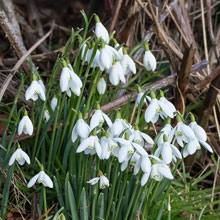
|
Fairlie:
I parked the car at a roadside car park just past the tall wooded embankment that shelters the old Hunterston ore terminal .
I clambered up the embankment to view the large basin of water inside
the terminal grounds to determine if birds were sheltering there.
Indeed they were. Hundreds of mainly Wigeon filled the entire waters. As
the sunlight was behind the birds and it was impossible to get any
closer, due to the perimeter fence, I walked along to the end of the
promontory, ocasionally getting a view down to the Fairlie sands
below. There I spied Curlew, Mallard and Teal foraging for
invertebrates in the damp sands. ( I sat in a very warm and
sheltered car, catching some zzzz's..JP)
| Wigeon |
Curlew |
Mallard |
Teal |

|

|

|
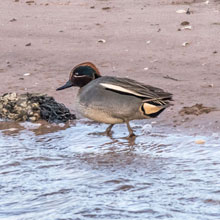
|
Just as I came off the bank down to the shoreside path, dog walkers put
the birds up but in doing so enabled a nice shot of a Curlew in flight
(see “Pictures of the Week”, below). As I returned to the
car, a Rescue Helicopter passed overhead heading towards Largs. A short
time later a couple of ambulances raced along the A78 also towards
Largs. Later I found out that there had been a capsized boat off the island of Cumbrae
resulting in people in the water. On a house near where the car was
parked I noticed the quite surreal sight of a gorilla wearing a
military helmet. Just exactly why this life-sized figure was on the roof
is a mystery. We drove the short distance to the car park at the
Fairlie Sands. The wind was still vicious and the birds we saw were
struggling to feed. A pair of Mallards were dabbling in the mouth of
the Fairlie Burn. The female seemed to have a unusually large beak.
Several Black-headed Gulls were rooted to their positions on the
seashore, no doubt waiting for the wind to subside.
|
|
Mallard |
Black - headed Gull |

|

|

|

|
We walked a short distance along the charming shore path scanning for
birds sheltering from the gale. There were few birds. Three Redshanks
moved gingerly along the shore. Also, a Common Gull
probed seaweed, guarding it from the Redshanks. Overlooking the scene
from its high vantage point, a Magpie grasped the swaying branches. In
an adjacent tree a lone Starling was our final picture of the visit.
| Redshank |
Common Gull |
Magpie |
Starling |

|

|
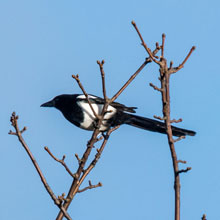
|

|
It was a windswept visit in which we tried our best to find the birds.
We made no great discoveries but we did manage pictures of the
braver birds as well as discovering some interesting facts about the
area. We supped tea inside the car this week comforted by a pair of
chocolate cream eclairs - each! ( They are small!! JP)
Pictures of the Week:
| Robin |
Herring Gull |

|

|
| Curlew |
Redshank |

|

|
20th January 2019:
Stevenston Point and Troon
It was another depressing Saturday evening when I learned of the
weather predicted for Sunday - dull and wet throughout Central
Scotland, with only a small chance it might clear from the west by
mid-afternoon. We headed west then, to Stevenston Point, via a pair of
excellent breakfasts in Stevenston Morrisons (9/10: -1 for slow
service).
Stevenston Point:
It was indeed dull on the Point, but the rain had just about stopped as
we arrived. To our delight, we saw some Sanderling on the rocks just off
the north side. The usual Shags were coming and going, and the
Sanderlings were disturbed by the comings and goings of the occupants
of the cars parked on the Point. Other fliers we saw were a couple of
pairs of Red-breasted Mergansers, the drake chasing a female.
A big Carrion Crow and a Herring Gull flew over the rocks and offshore a
Cormorant flew by, skimming the surface on its way south. Another of the
“usual suspects” was not hard to find - the Oystercatcher.
They were taking a high tide roost on the rocks off the end of the
Point. Occasionally one would relocate as the conditions changed.
| Carrion Crow |
Herring Gull |
Cormorant |
Oystercatcher |
 |
 |
 |
 |
On the rock where we saw the Sanderlings earlier I could see a few Purple Sandpipers
pecking at the surface for tiny morsels of food. Not far away, a
yawning 2nd-year Herring Gull was finding the grey day a bit of a bore.
Meanwhile, a Ringed Plover flew in, disturbing a Redshank from its
slumber. We noticed that there were small areas of blue sky peeping
through the gloom so we decided to move to Troon where a pair of Water
Pipits had been seen. On our way off of the Point John spotted some
Greenfinches in the roadside bushes, so I pulled in to allow him to snap
a few images. These birds have had a hard time in recent years due to
an epidemic of a parasitic disease, Trichomonosis . Numbers plunged by 60% in 10 years but now seems to be improving in a few areas.
| Purple Sandpiper |
Herring Gull |
Ringed Plover / Redshank |
Greenfinch |
 |
 |
 |
 |
Pictures of the Week 1:
| Herring Gull |
Greenfinch |
 |
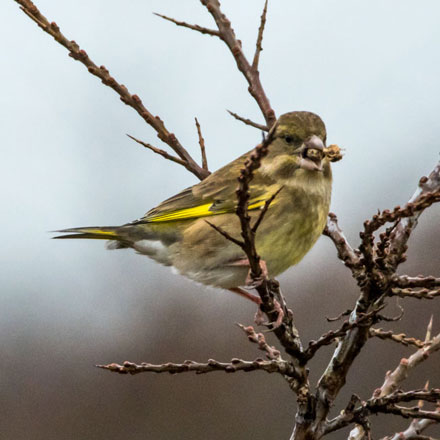 |
| Curlew |
Redshank |
 |
 |
Troon:
On arrival at the Harbour car park I could see a large flock of about
100 Dunlin roosting on the rocks. They were very static with only a few
individuals showing their bills, the rest having tucked theirs snuggly
under their wings. In the midst of the flock sat a juvenile Herring Gull
watching me taking pictures. We started walking south to where the
Water Pipits had been seen. We startled a Curlew that had been sitting
in silhouette on the rocks. It few north to a bit less busy area of
rocks. As we cautiously edged our way along the tricky damp and slippy
path at the base of the Ballast Bank, John noticed a patch of green
vegetation clinging to the stonework. It is yet to be identified.
| Dunlin |
1st Cycle Herring Gull |
Curlew |
T.B.C |
 |
 |
 |
 |
At the south end of the Ballast Bank we came upon an area of seaweed on
the rocky shore where we found a few birds busily picking their way
through the weed. A couple of male Pied Wagtails and a Rock Pipit were
having a field day catching flies and creepy crawlies until a flock of
manic Starlings descended onto the smelly piles and displaced the
smaller birds. I enjoyed trying to catch shots of the Starlings jumping
into the air as they tried to catch flies.
| Pied Wagtail |
Rock Pipit |
Starling |
Starling |
 |
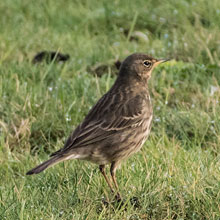 |
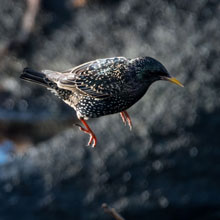 |
 |
Eventually we reached the Titchfield Road car park where John pointed
out that there was a juvenile Grey Heron on a large rock. I moved
across the rocks to get a better lit shot and very obligingly the bird
moved its head into the light so making a nice pose. We pushed on
through a public garden where a pair of House Sparrows were
interacting. The female carried a white feather in its beak, the male
trailing behind her. Over the sea wall a pair of Ringed plovers were
enjoying the sunshine, allowing me a chance for a decent shot. As we
neared our intended destination we came upon small number of Turnstone
foraging the rocks just below the sea wall. They seemed unconcerned by
the many people passing above them, certainly less concerned than me,
as I was worried that the beach ahead seemed to be filling with dog
walkers and children, usually not a good mix for nature watching.
| Juvenile Grey Heron |
House Sparrow |
Ringed Plover |
Turnstone |
 |
 |
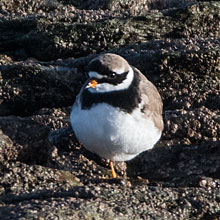 |
 |
Among the Turnstones I had spotted a significant number of Dunlin going
about their business, before a dog put them up. The flock disappeared
north. Less worried by the ever-increasing crowds, our second Pipit species
of the day, a Meadow Pipit, was dotting about the grass verges by the
roadside. We thought we had little chance of seeing the third, the
Water Pipit, until I noticed that the beach was laden with a massive
blanket of stinking seaweed - with very few people near it. And what do
Pipits just love to scour for invertebrates - seaweed. Reinvigorated,
we moved to the sea-side of the weed in order that the sun was behind
us, and walked back north along the shore, scanning the seaweed as we
went. John fairly quickly located a Water Pipit. It was quite mobile,
but I managed a few fairly decent photos. Mission accomplished! We
headed back along the promenade that nice feeling of success. As an
added bonus, while we rested just before the Ballast Bank, John
discovered an unfamiliar duck. I got as close to it as I could,
although it was silhouetted by the sunlight, but the pictures show its
main features. Later we identified it as a hybrid from a drake Mallard
and Eider duck. I also found out from a Facebook comment that it had
been seen there over the last couple of years.
| Dunlin |
Meadow Pipit |
Water Pipit |
Mallard x Eider Hybrid |
 |
 |
 |
 |
Back at the car we treated ourselves to strong tea and, for a bit of a
change, a selection of mini- Danish pastries. They were very fine. So
the visit started in dull conditions and brightened as time went on.
Pictures of the Week 2:
| Pied Wagtail |
Turnstone |
 |
 |
| Starling |
Water Pipit |
 |
 |
13th January 2019:
Figgate Park ( Maps) and Duddingston Loch
Throughout the whole of last week I had been seeing reports on Twitter
of a pair of Otters showing off in the pond in Figgate Park, Edinburgh.
Naturally I decided that it would be a great idea to get John and I
down there for our Sunday outing to see them for ourselves. The weather
prediction was optimistic- windy with sunny intervals with little
chance of rain, so it was all systems go! We had breakfast in the ASDA
Superstore at Brunstane, a place we last visited a few years ago. The
food was ok but we found the service a bit unfriendly (7/10).
Figgate Park, Edinburgh (Website)
Soon after, we had parked Baileyfield Road and were entering the park
and being amused with the sight of a small, pimped-up works container
whose sides had been adorned with beautiful spray-painted birds. We
walked round the pond to the wooden feeding platform. On the pond, by
the island, a pair of young cormorants
were squabbling over the the rights to a rocky perch. A wee Blue Tit
tweeted from the bushes just above us while a few Mallards loitered
near us watching for any feeding opportunities. (Also see
“Pictures of the Week 1”, below).
|
Juvenile Cormorant |
Blue Tit |
Mallard |
 |
 |
 |
 |
A family of Mute Swans occupied the centre of the pond. The cygnets
were nearly fully grown, their plumages nearly all white with only a
few tinges of pale brown. (See “Pictures of the Week 1”,
below). Behind, in the distance, we could make out hordes of
early-morning climbers on the peak of Arthur’s Seat ,
the remains of an ancient volcano. Meanwhile in front of us, the
Blackheaded Gulls were getting frisky. Could the Otters be nearby?
| Mute Swan |
Robin |
Arthur's Seat |
Black - headed Gull |
 |
 |
 |
 |
The Tufted Ducks were looking a bit sheepish and a young Moorhen looked
more nervous than usual. As we moved around the pond towards the
boardwalk, we scanned the water for any signs of Otters but we
couldn’t see any. We met a respected fellow nature watcher who
informed us that a pair of Otters had been seen the previous day on
Duddingston Loch, which, apparently is linked to the Figgate pond by
the Figgate Burn. However, we then noticed that people had crowded to
one end of the boardwalk and were scanning the reeds for, could it be
the Otters? Well no, it was a Water Rail that had captured
their interest. I managed a few nicely-lit shots of the rarely seen
bird, but it didn’t make up for the no-show Otters. A very
friendly female Blackbird appeared, probing the area around our feet. I
had to move back slowly before I could get a decent focus. It
obligingly posed as I snapped I quick couple of shots.
| Tufted Duck |
Moorhen |
Water Rail |
Female Blackbird |
 |
 |
 |
 |
So, sad to say, the Otters didn’t make an appearance. We did see
a lot of nice birds, the Water Rail being the most pleasing.
Pictures of the Week 1:
| Common Cormorant |
Drake Mallard |
 |
 |
| Juvenile Mute Swan |
Water Rail |
 |
 |
Duddingston Loch, (Website) Holyrood Park, Edinburgh
Having dipped on the Otters at Figgate Park we thought they may have
moved up the burn to Duddingston Loch . We parked in a public
car park off Old Church Lane, which is more or less at the foot of the
peak mentioned above. We walked to a quiet spot by the Loch, past a flock
of grazing Canada Geese, and parked ourselves beside a wall to shelter
from the stiff breeze. We could see that there were many birds on the
water that were sheltering in calmer water by the edge of the Loch.
After a patient wait for some sunshine, a handsome wee Coot popped up
through the water. We were checked out by a large Herring Gull as I
attempted to get a picture of a Little Grebe that was fairly near the
water’s edge.
| Canada Goose |
Coot |
Herring Gull |
Little Grebe |
 |
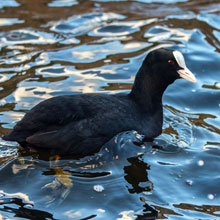 |
 |
 |
We decided to walk along to Hangman’s Rock . I fancied
some shots of the water birds side-lit by the low winter sun, and, from
the path, we may have seen some birds in the bushes. On the path ahead
of us, a pair of Jackdaws were cautiously feeding, before I managed to
put them up. Beyond them, Mute Swans and Canada Geese were gathered at
an area where tourists gathered for a rest and snacks. Amongst the
expectant birds were a gorgeous cock Pheasant and a hybrid goose, a
Canada and Greylag cross (See “Pictures of the Week
2”, below).
| Jackdaw |
Mute Swan |
Pheasant |
Greylag X Canada Goose |
 |
 |
 |
 |
From Hangman’s Rock I had a commanding view of the Loch but could
see no signs of the Otters. On the water, near the shore, Mallards,
Tufted Ducks, Goldeneyes and Wigeon were moving in and out of the
shadows making it tricky to capture any decent shots (see also
“Pictures of the Week 2”, below). A familiar call from
overhead signalled the approach of a Buzzard that hovered above us for
a short time. On the walk back to the car I heard another well know
bird call, that of a male Bullfinch that was nibbling on the twigs of
the bushes that lined the edges of the Loch. It was our final picture of
the day.
| Tufted Duck |
Wigeon |
Common Buzzard |
Bullfinch |
 |
 |
 |
 |
It had been an enjoyable trip, our second week away from the coast. The
Water Rail kinda saved the day. Our teas were washed down with some tasty
slices of Sponge cake, one of my own creations. Positive comments were
offered from John, so I’m pleased. I’m less pleased with the
Otters though! I have seen Otters many times, particularly on the River
Clyde at RSPB Baron’s Haugh , but you can never see too
many Otters.
Update: I write this on the Tuesday after and I’ve read Twitter
messages from people who have posted pictures of the Otters on each day
from the Wednesday before to Tuesday, except on Sunday - typical! I
suppose it could’ve been down to the high density of people in
the park.
Pictures of the Week 2:
| Coot |
Pheasant |
 |
 |
| Greylag x Canada Goose |
Mallard |
 |
 |
6th January 2019:
Hopes Reservoir
The weather prediction was for dull weather throughout, but with rain
in the west and the prospect of coastal mist. Luckily though I had been
following Twitter reports of a big Redpoll flock at Hopes Reservoir high
in the Lammermuir Hills in East Lothian, a new place for us. So
following our usual breakfast in Dalkeith Morrisons (8.5/10: nice but a
poor fried egg and drippy teapot let it down) we travelled the winding
route through narrow country roads, the last of which was single track,
eventually reaching a dead end at a spacious car park. As we started
our walk from there, along a well prepared path down a gradual slope
towards the Reservoir, John commented how quiet it was with only the
occasional calls of the Red Grouse interrupting perfect silence.
Eventually we reached a wooded area where I spotted a Robin and, high
in the trees, a small bird that could have been our first sighting of a
Redpoll. silhouetted against the grey sky but it might have been our
first Redpoll of the visit.
In the same tree I caught a brief view of a female Bullfinch, also
poorly lit. Just as we entered the wood I managed a picture of a pair
of Pheasants, a cock and hen. Some trees had trunks covered in pale green lichen .
Eventually we reached the Reservoir dam. Hopes Reservoir covers
approximately 40 acres of land and was opened in 1933. I have read that
part of the dam wall was built using rubble from Calton Jail in Edinburgh, which was demolished in 1930. We scrambled along a narrow
mucky path on the north side of the reservoir. Below us on the water
there was a solitary Cormorant fishing, but that was all we saw.
| Bullfinch |
Pheasant |
Lichen |
Cormorant |
 |
 |
 |
 |
Below is the a picture that captures the overcast conditions and yet
shows the appealing view from the west end of the Reservoir as we
looked back to the dam.
Just as we were about to give up ever finding the Redpolls we noticed a
small gathering of birders on the south side of the water. They seemed
to be scanning the water, but we went on to find they were looking at a
large Redpoll flock. The majority of the birds were Lesser Redpolls.
They have warm brownish tones around the head, mantle, and wings that
often distinguishes them from other Redpoll species.
We could see one of those other species, the Mealy (or Common) Redpoll.
It shows a bit more cold and greyer plumage than the Lesser.
We saw one bird that stood out from the rest due to its very pale
tones. It was a Coues’s Arctic Redpoll (sometimes called the
Scandinavian Arctic Redpoll), which breeds in Northern Europe eastwards
into Siberia. We studied the flock (see the “Pictures of the
Week”, below) for a half hour in ever-deteriorating light before deciding to move on. As we returned
to the dam I snapped one of the dozen or so Mallards present off the
water and also a passing Buzzard.
On our way down the Reservoir-side road we came across a patch of Silver Birch trees that hosted Birch Polypore
fungi. These were a variety of shapes and sizes. The game birds had
been calling throughout our walk and we got a fairly close view of one,
a Red Grouse, as it flew past us at speed after we had caught it
unawares close to the road. The car was still a mile off but the view
was idyllic (see the “Pictures of the Week”, below).
We saw further Red Grouse as we plodded on towards the car. One of
these, a hen, was very reluctant to move from where out had been
feeding on the road. John noticed that some kind soul had left a trail
of seed (or maybe they were not so kind - they shoot the grouse in that
area!). We managed to put up another game bird, a Pheasant, that sped
into the vegetation on the opposite slopes. Our final picture of the day
was taken by John from the passenger seat of the car as we were leaving
the estate. A few bold Pheasants were loitering on and around the road,
just asking for their pictures to be taken (see also the
“Pictures of the Week”, below).
Despite the weather we were very satisfied with the sighting and
pictures. Once again we achieved our main goal - finding the Redpoll
flock and more specifically the Coues Arctic Redpoll. Apple Lattice
Danish pastries washed down with strong tea ended the very enjoyable
afternoon. Hopes Reservour was new ground for us and we’ll
definitely return there.
Pictures of the Week
| Redpolls |
Lesser Redpoll |
 |
 |
| View |
Pheasant |
 |
 |
Back To Top
|

